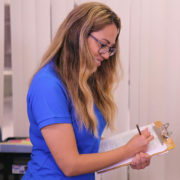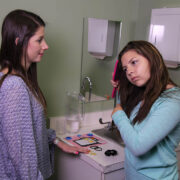How To Find An ABA Therapy Provider
Many questions arise when a family receives a diagnosis of Autism or a referral to receive ABA services. How do I find an ABA therapy provider and program? Who’s going to work with my child? What are my expectations? Am I going to be involved in this program? What is my child going to work on? We want to help you with what questions are good to ask and in general what a good answer to those would be when looking for an ABA provider.
Here’s a list of questions and things to look for when looking to find an ABA therapy provider and services for your loved one.
Q: “What qualifications do the staff have?
A: The staff at an ABA facility should have the following credentials:
- Registered Behavior Technician (RBT): This will be the direct care professional that will work directly with your child for their direct treatment hours. Technicians working with your child should either have this credential or be in the process of getting it (new to the field/company). The RBT credential requires at least a high school diploma, a 40 hour RBT course, a competency assessment done by a BCBA or other qualified person, passing the RBT exam, and ongoing supervision (5% of hours worked) by a BCBA or BCaBA.
- Board Certified Assistant Behavior Analyst (BCaBA): This will be a professional that works directly with the clients and assists the BCBA with assessments, creating programs, training staff, and parent training. This credential requires a Bachelor’s degree, at least 1000 hours of fieldwork supervision, passing the BACB test, ongoing supervision by a BCBA, and 20 continuing education credits every 2 years (including 4 in ethics and 3 in supervision).
- Board Certified Behavior Analyst (BCBA): This is the professional that will be in charge of evaluating your child, creating/updating/modifying your child’s program, training/monitoring technicians, and providing caregiver training. This credential requires at least a Master’s degree, at least 1500 (soon to be 2000) hours of fieldwork supervision by an experienced BCBA, passing the BACB exam, and 32 continuing education credits every 2 years (including 4 in ethics and 3 in supervision).
Q: “How often are staff trained and evaluated?
A: All staff should go through general training for the RBT credential and for the basics of applied behavior analysis. They should also receive individual training with each client they will be working with. There should also be a predetermined criteria (example: 90% correct on a performance evaluation) for when staff is considered adequately trained on each client. All RBTs should receive supervision working with a client for at least 5% of the total time they work with clients each month. How often evaluations will be done will vary by company. At Behavior TLC we typically do evaluations with each employee at least 1 time per month.
Q: “How many staff will work with my child?”
A: In general it is best to have multiple therapists work with your child. This helps ensure that the skills they learn can be done with a variety of people and helps make it more likely that they will be able to do those things at home or with people in other settings such as school. For a child that is receiving comprehensive services, it is common for them to have a team of up to 6 therapists. Your child should only have one BCBA that oversees their caseload.
Q: “What is the client to staff ratio throughout the day?”
A: For traditional ABA therapy the client to staff ratio should always be 1:1. Some exceptions to this may be a program that is transitional and works on teaching children to learn in a group setting.
Q: “Do you provide parent/caregiver training and what is that like?”
A: Parent/caregiver training should be a standard service offered with all ABA intervention. During parent/caregiver training the BCBA or other qualified therapist (BCaBA or Lead Therapist/Graduate Supervisee) teaches the parents/caregivers the techniques that have been found to be successful during treatment at the clinic. Parent/caregiver training is generally offered at least monthly.
Q: “Can I observe my child’s sessions?”
A: In general parents/caregivers observing sessions can be very helpful. Many facilities have camera systems and have an observation room for parents/caregivers to be able to observe sessions without inadvertently disrupting the session.
Q: “Do you collaborate with other therapeutic and healthcare providers my child has?”
A: A collaborative and team approach is incredibly important to a child’s progress. In general, when you find an ABA therapy provider, they should collaborate with other professionals (school, medical, etc.) your child works with.
Q: “What is the annual schedule like?”
A: This will vary across clinics. Most clinics are open year-round and are only closed for major holidays.
Q: “How often will I be updated on my child’s progress?”
A: Generally you should get a daily report and overview of how the day went. Monthly reports of progress should also be provided and additional updates can be given during parent meetings. Also, your child should be re-evaluated every 6 months with the initial assessment used.
Q: “How often will my child’s programs be evaluated or updated?”
A: Your child’s programs should be reviewed and updated (as needed) at least weekly. Many clinics utilize electronic data collection systems making it easier to review and modify programs regularly.
Q: “How are the programs my child works on chosen?”
A: The programs that are chosen for each client should be guided by the assessment used during the initial assessment done by the BCBA and by information gathered from the parents/caregivers and what their priorities are for treatment. Additional programs and changes to programs are likely to occur over time based on the child’s response to therapy, the BCBA’s observations of the child, and continued collaboration with parents/caregivers and other providers.
Q: “What types of assessments do you use?”
A: The ABLLS (Assessment of Basic Language and Learning Skills), VB-MAPP (Verbal Behavior Milestones Assessment and Placement Program), AFLS (Assessment of Functional Living Skills), and the PEAK (Promoting Emergence of Advanced Knowledge) are common assessments that are used.
Q: “How often will assessments be done with my child?”
A: Full reassessments of the initial assessment tool used should occur at least every 6 months.
Q: “Who handles authorizations and denied authorizations or claims?”
A: In general it should be the ABA provider that handles all authorizations and denial of claims or requested authorizations. The parent/caregiver should always be informed of denials especially in regard to requested authorization for services.
Q: “How are maintenance and generalization of skills taught to my child handled?”
A: Typically the maintenance and generalization of skills taught are addressed in several ways. Multiple technicians work with your child. Multiple examples of what we are teaching are used during teaching sessions (example: if we are teaching your child to label a picture of a cat we will have 4-6 pictures of different cats). Skills will be worked on in several environments (for example – outside, in a group time or common area, and in the treatment room).
Q: “How do you address goals for group learning?”
A: Group times should be incorporated throughout the day. How often and what those group therapy times look like will vary based on your child’s current goals for group learning and their age. Some examples of typical group times that may be incorporated into the day are meal times, circle time (similar to preschool or kindergarten), arts and crafts, holiday celebrations, group games/activities.
Q: “What services do you offer when it’s time for my child to move to a different setting such as school?”
A: A transition to a new environment should be a process that occurs over a few months. Typically the types of transition services you should expect would be a review and release of current record such as the behavior support plan. A meeting with the relevant individuals for the new setting (teachers, principal, etc.), possible training of those people, and potentially providing a shadow for a brief period (up to 6 months) to ensure that all skills generalize to the new setting.
Q: “How much time will the BCBA spend with my child?”
A: A BCBA should spend at least 10% of the total direct hours your child has (direct therapy with a technician) in order to review, modify, and update your child’s program each week. Example: If your child has 30 hours of direct services with a technician, the BCBA should spend on average 3 hours with your child each week.
Q: “How often will a BCBA be on site?”
A: For a clinic setting you will want to find an ABA therapy provider that has a BCBA onsite for at least the total number of supervision hours required for each client (10% of 1:1 hours with an RBT). Ideally for a clinic setting a BCBA should be on-site for close to 100% of operational hours. For in-home ABA services, you should expect the BCBA to be “on-site” for at least 10% of the direct treatment hours either in person or via telehealth.
Q: “Have you taken any additional precautions during the Covid 19 Pandemic?”
A: Good precautions to look for:
- Wellness checks for clients and staff including a temperature check each day.
- All staff wearing masks when in common areas or in a room with another person.
- Clients wearing masks as they will tolerate. Also working on this skill as needed.
- Masks and temperature checks for anyone who enters the building.
- Frequent hand washing and sanitizing.
- Staggered drop off and pick up times.
- Regular sanitizing of the clinic (having a person available when possible during the day to clean/sanitize).
- Regularly scheduled professional cleaning (1 to 2 times per week).
- Additional professional cleaning and sanitizing as possible/needed.
- Limiting the number of clients to a room to 1 and only having multiple clients in a room in which proper spacing (at least 6 feet) is possible.
- Procedure for reporting suspected or confirmed cases of Covid.
These are good questions for you to ask when working to find an ABA therapy provider. It is crucial to receive high-quality ABA services. It is important to have high expectations on staff’s training and being involved in the program. This includes keeping the family informed and having frequent communication. We hope these questions help you find the best place for your family!











